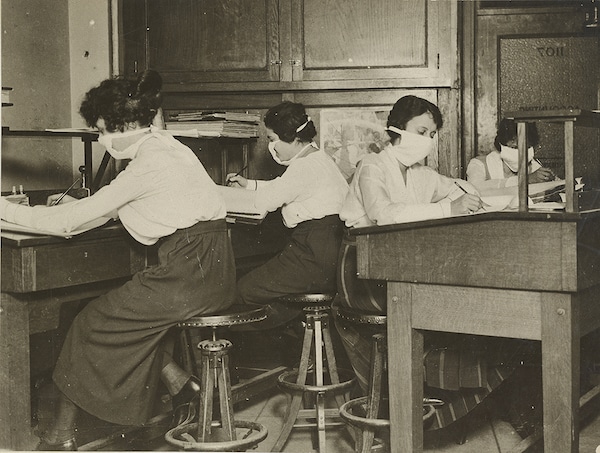
Female clerks in New York City wear masks at work during the Spanish Flu. Source: National Archives
As we start to see a “light at the end of the tunnel,” I thought it was only appropriate to explore the lessons we’ve learned. But after reading about the changes and realities resulting from the 1918 Spanish Flu, it seemed more appropriate to reflect on where we are and how history has, and will, shape our future. So, as we reflect on our history, let’s ponder the possible positive changes in the food, health and agriculture realms as we move forward.
From historical accounts of the Spanish Flu we know that health care workers were challenged to treat all the sick, restaurants were closed and the economy stalled. However, by 1920, the decade came roaring in and new scientific, social and economic pursuits emerged. Here is a glimpse of some of the positive changes:
- Revolution in Public Health and Data Collection – The U.S. Public Health Service was created in 1910 but there was not a centralized system in 1919 for reporting or treating disease, which prevented the sharing of information or medical practices to control the spread of the Spanish Flu. By 1925, a national disease reporting system was established in every state in the United States and by 1935, the initial national health survey was established. The cornerstone of public health, epidemiology, was created when countries realized to prevent, manage or treat future pandemics, understanding the cause and effect of disease was essential.
- Coordinated International Response – The World Health Organization, as we know it today, was established following the 1918 pandemic as countries recognized that the inability to share healthcare data impaired a coordinated response. Those behind creation of the WHO believed that improved coordination could decrease the impact of future pandemics.
- Improved Understanding of Viruses – Viruses were not understood in 1918 as scientists originally thought flu was caused by bacteria. There were no tests or vaccines. After 1918, more developing countries embraced scientific methods and modern medicine. Today, a global surveillance system is in place.
- Enhanced Hygiene and Sanitation – Basic sanitation and hygiene guidelines — from hand washing to wearing masks — were implemented during the outbreak, which was recognized as a “crowd disease” with rapid spread among poor living conditions in crowded cities and World War I U.S. military camps. Inequities were exposed and the most vulnerable populations suffered the greatest loss.
Following the 1918 Spanish Flu, optimism abounded and economics rebounded. Most notably, women won the right to vote (a definite positive change) and surge in wealth, innovative and change moved the country into a new era. So, what will we learn from this history? Despite the positive steps noted over a 100 years ago, there are some themes that sound all too familiar. We have the opportunity to address the gaps. Will we accept the challenge?
______________________________
Content adapted from “Positive change from tragedy: 10 major changes that resulted from the 1918 Spanish Flu pandemic,” Daily Mail, June 25, 2020.
Other Resources:
Public Health in the United States, Boston University Medical Campus.
The Flu Pandemic of 1918, National Archives News, The U.S. National Archives and Records Administration.
